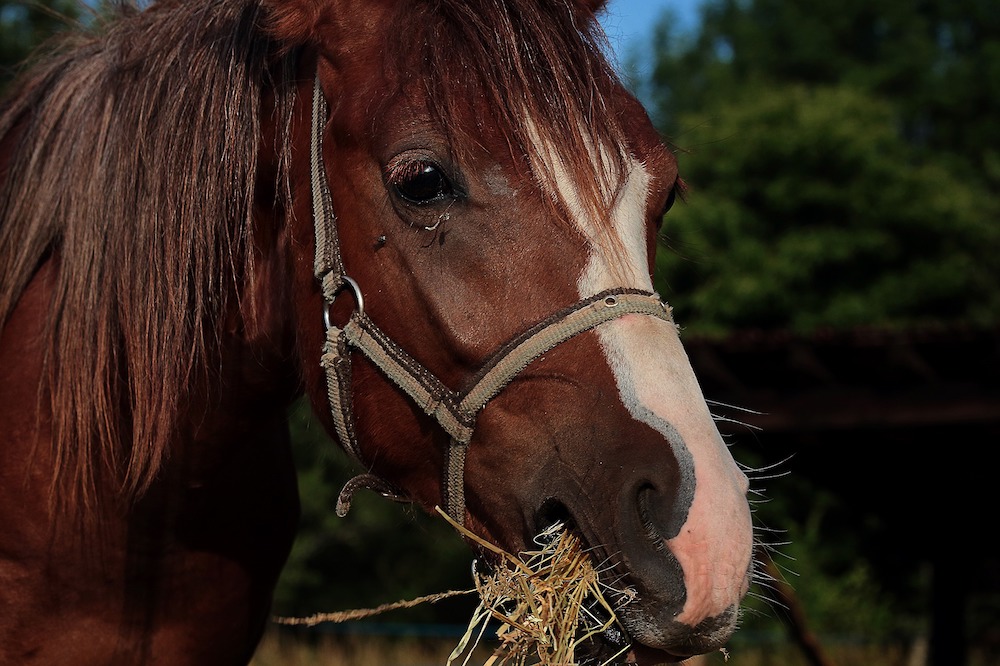What is Restricted Feeding?
08/28/2017

On one level, it’s exactly what it sounds like – restricting what you feed your horse. The devil is in the details though. Exactly what is being restricted, why, how much?
Some people use restricted feeding and slow feeding synonymously. In that case, the horse is restricted in how fast they can eat. This may or may not end up also reducing how much they eat. Some horses become very adept at eating from small hole nets or slow feeders. Others simply spend more time eating. Either way they can end up eating as much as they did before.
In most cases restricted feeding refers to limiting how much the horse is given to eat. That may mean just cutting back on grain or pasture time but usually means the horse’s daily calorie intake from all sources is controlled to maintain a healthy weight. Situations where this is necessary include overweight horses needing to trim down, insulin resistant horses that will eat too much and horses on forced stall rest for an injury.
Contrary to what you may have heard, restricting caloric intake is not the most stressful thing you can do to your horse. It is not cruel and will not cause health problems when done properly. While some advocate extreme calorie restriction, especially when trying to get weight off a horse, this really isn’t necessary.
A grass hay with under 10% sugar (ESC) and starch combined, protein 9+% can usually be fed at a rate of 1.5% of current body weight or 2% of ideal body weight, whichever is larger, to achieve the desired weight. Use a slow feeding set up and break this up into multiple feedings. If the horse is able to be regularly exercised they can eat even more.
It’s worth mentioning here that these guidelines also work for insulin resistant horses most of the time. It’s not so much that they gain weight easily but rather that they eat too much. When a horse is not losing weight at the above level of feeding a calorie count using the actual digestible energy from the hay analysis usually reveals the hay has higher than average calorie density. There are some individuals that need more stringent restrictions but they are the exception rather than the rule.
Don’t worry about the gut being “empty” if the horse is not constantly eating. It takes the stomach a bare minimum of 2 hours to empty, usually much longer. Running out of hay for a couple hours also does not guarantee stomach pain, “stress” or ulcer formation.
As for feeding the organisms in the hind gut, food takes about 2 days to finish traversing the hind gut. It is not true the horse’s cecum won’t empty without a constant flow of food to push the contents along. Just like everywhere else in the intestinal tract, food is mixed and propelled along by muscular contractions which occur at set intervals. The time food spends in the cecum depends on particle size and ranges from 2 to 48 hours (Argenzio 1974).
Whether it’s a human, a horse or the family dog or cat, weight control still boils down to calories in versus calories out. Horses that are overweight or have sharply curtailed activity need to have their calories counted. Horses which overeat for medical or temperament reasons also need to have calories restricted. Restricting calories to those needed to maintain a normal weight is not extreme. It’s really that simple.
The ECIR Group has hundreds of case histories to prove it. Join us in October in Tucson, AZ, for the 2017 NO Laminitis! Conference to learn more. www.nolaminitis.org
About ECIR Group Inc.
Started in 1999, the ECIR Group is the largest field-trial database for PPID and IR in the world and provides the latest research, diagnosis, and treatment information, in addition to dietary recommendations for horses with these conditions. Even universities do not and cannot compile and follow long term as many in-depth case histories of PPID/IR horses as the ECIR Group.
In 2013 the Equine Cushing's and Insulin Resistance Group Inc., an Arizona nonprofit corporation, was approved as a 501(c)3 public charity. Tax deductible contributions and grants support ongoing research, education, and awareness of Equine Cushing's Disease/PPID and Insulin Resistance.
THE MISSION of the ECIR Group Inc. is to improve the welfare of equines with metabolic disorders via a unique interface between basic research and real-life clinical experience. Prevention of laminitis is the ultimate goal. The ECIR Group serves the scientific community, practicing clinicians, and owners by focusing on investigations most likely to quickly, immediately, and significantly benefit the welfare of the horse.

